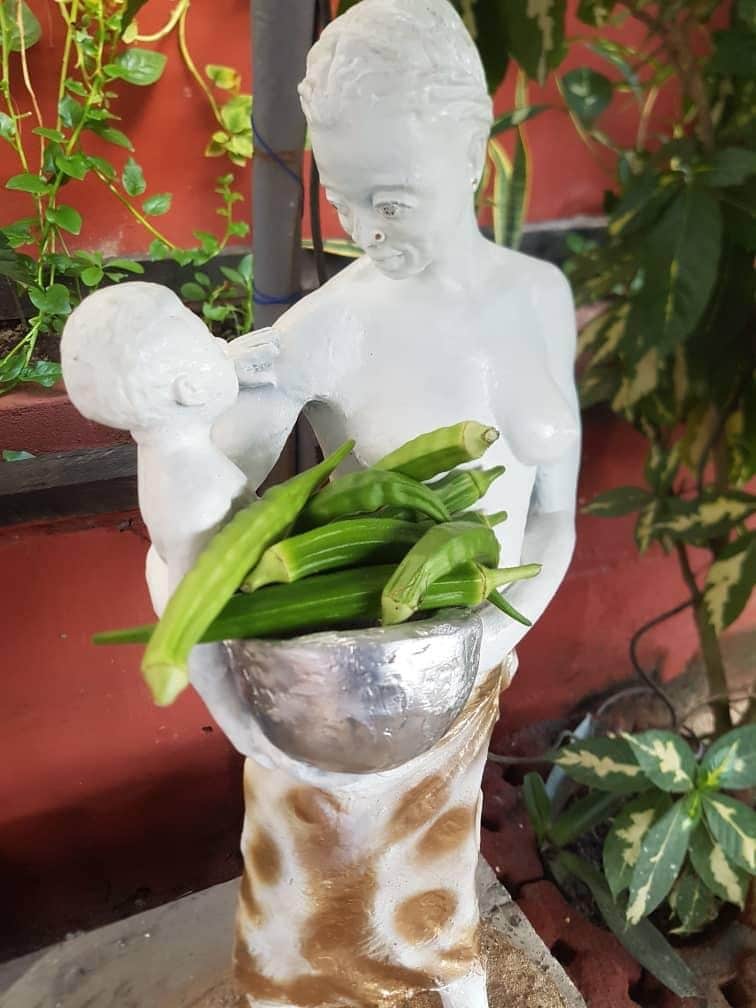Discover the fascinating journey of okra farming in Ghana, as we delve into the step-by-step process from seed to harvest. Known for its vibrant green pods and nutritional benefits, okra has become a staple crop in Ghana’s agricultural landscape.
Thank you for reading this post, don't forget to subscribe!Join us on this captivating journey as we explore the meticulous planning, planting, nurturing, and harvesting techniques employed by Ghanaian farmers to ensure a bountiful yield. From selecting the finest okra seeds to preparing the fertile soil, each step is carefully executed to maximize productivity and quality. Explore the challenges faced by farmers and the innovative strategies they employ to overcome them, including pest control, irrigation, and sustainable farming practices. Whether you’re a seasoned farmer, a curious enthusiast, or simply interested in the intricate process behind the food on your plate, this article will provide valuable insights into the remarkable journey of okra farming in Ghana.
Benefits of Okra Farming
Okra farming in Ghana offers numerous benefits for both farmers and consumers. Firstly, okra is a highly nutritious vegetable that is rich in fiber, vitamins, and minerals. It is known to improve digestion, boost immunity, and promote healthy skin. By cultivating okra, farmers have the opportunity to contribute to the local food supply and provide nutritious produce for their communities.
Additionally, okra farming can be a profitable venture for farmers. Due to its high demand both domestically and internationally, okra has the potential to generate a steady income for farmers. The export market for okra is particularly lucrative, with Ghana being a major supplier to countries in Europe and North America. This presents an excellent opportunity for farmers to tap into global markets and increase their earnings.
Moreover, okra farming is environmentally friendly. Okra plants have a natural ability to improve soil quality by fixing nitrogen and reducing the need for synthetic fertilizers. This helps to preserve the ecosystem and minimize the negative impact of chemical inputs on the environment. Furthermore, okra plants are relatively drought-tolerant, making them suitable for cultivation in areas with limited water resources.
In summary, the benefits of okra farming in Ghana are manifold, ranging from improved nutrition and economic opportunities for farmers to sustainable agricultural practices that protect the environment.
Climate and Soil Requirements for Okra Farming
Okra is a warm-season crop that thrives in tropical and subtropical regions. It requires a minimum temperature of 20°C (68°F) for optimal growth and development. In Ghana, okra farming is most successful in areas with a long growing season and a consistent temperature range of 25-35°C (77-95°F).
In terms of soil requirements, okra prefers well-drained loamy, or sandy soils with a pH range of 6.0-7.5. It is important to ensure that the soil is rich in organic matter and has good moisture-holding capacity. This can be achieved through the addition of compost or well-rotted manure before planting. Proper soil preparation is crucial to create a favorable environment for okra plants to establish strong root systems and absorb essential nutrients.
Selecting the Right Okra Seeds
Choosing the right okra seeds is a critical step in the farming process. Farmers should select high-quality seeds that are disease-resistant and have a high germination rate. It is advisable to purchase seeds from reputable suppliers or seed companies to ensure their authenticity and quality.
When selecting okra seeds, farmers should consider the desired characteristics of the variety. There are different types of okra, each with its unique traits. Some varieties have larger pods, while others have a higher tolerance to pests and diseases. Farmers should choose varieties that are well-suited to their specific growing conditions and market demands.
Preparing the Land for Okra Cultivation
Before planting okra seeds, it is important to prepare the land properly. The first step is to clear the field of any weeds, rocks, or debris that may hinder the growth of okra plants. This can be done manually or with the help of machinery, depending on the size of the land.
Once the field is cleared, farmers should plow or till the soil to a depth of 20-25 centimeters (8-10 inches). This helps to loosen the soil and improve its structure, allowing for better root penetration and water infiltration. After tilling, the soil should be leveled and any large clods of soil should be broken down to create a smooth surface.
After leveling, farmers should incorporate organic matter, such as compost or well-rotted manure, into the soil. This helps to improve soil fertility and moisture retention. The organic matter can be spread evenly across the field and incorporated into the soil using a tractor or manual labor.
Sowing Okra Seeds
Farmers can choose to sow the seeds directly in the field or start them in a nursery and transplant them later. Both methods have their advantages and depend on the specific circumstances of the farmer.
When sowing directly in the field, farmers should create furrows or ridges spaced about 60 centimeters (24 inches) apart. The depth of the furrows should be around 2 centimeters (1 inch). The seeds can be sown thinly along the furrows, ensuring a spacing of about 10 centimeters (4 inches) between seeds.
If starting the seeds in a nursery, farmers should sow them in trays or pots filled with a well-drained seedling mix. The seeds should be planted at a depth of about 1 centimeter (0.4 inches) and covered lightly with soil. The trays or pots can be kept in a shaded area until the seedlings emerge.
Regardless of the method chosen, it is important to water the seeds immediately after sowing to ensure proper germination. The soil should be kept moist but not waterlogged throughout the germination period.
Watering and Fertilizing Okra Plants
Okra plants require regular watering to ensure healthy growth and development. Adequate moisture is particularly crucial during flowering and fruiting stages. In Ghana, where rainfall patterns can be unpredictable, farmers often rely on irrigation to supplement water requirements.
Drip irrigation is an efficient method for providing water to okra plants. It delivers water directly to the root zone, minimizing water loss through evaporation and runoff. By irrigating at the base of the plants, farmers can also reduce the risk of foliar diseases caused by wet foliage.
In addition to water, okra plants also require balanced nutrition to thrive. Fertilizers can be applied during different stages of growth to meet the nutrient requirements of the plants. Before planting, farmers can incorporate a basal dose of organic or inorganic fertilizers into the soil. This provides a good foundation of nutrients for the plants.
During the growing season, farmers can apply side dressings of nitrogen-rich fertilizers to promote vigorous growth and fruiting. This can be done in two or three split applications, starting when the plants are about 30 centimeters (12 inches) tall. Farmers should follow the recommended rates and timing specified for the specific fertilizer they are using.
Controlling Pests and Diseases in Okra Farming
Like any crop, okra is susceptible to various pests and diseases that can reduce yield and quality. Common pests that affect okra plants include aphids, whiteflies, spider mites, and fruit borers. Diseases such as powdery mildew, bacterial leaf spot, and fusarium wilt can also pose significant challenges to okra farmers.
To control pests, farmers can employ both cultural and chemical methods. Culturally, farmers can practice crop rotation, intercropping, and the use of resistant varieties to minimize pest populations. Additionally, regular monitoring of the crop is essential to detect pests early and take appropriate action.
Chemical control measures, such as the use of insecticides and fungicides, may be necessary for severe infestations or disease outbreaks. It is important to follow the recommended dosage and application guidelines to ensure effective control while minimizing negative impacts on the environment.
Harvesting Okra Pods
Okra pods are ready for harvest approximately 50-60 days after sowing, depending on the variety and growing conditions. Harvesting should be done when the pods are young and tender before they become tough and fibrous. This ensures the best flavor and quality of the okra.
To harvest okra pods, farmers should use a sharp knife or pruners to cut the pods from the plant. It is important to handle the pods carefully to avoid damage. Harvesting should be done regularly, every 2-3 days, as the pods mature quickly. Leaving mature pods on the plant for too long can reduce the yield and quality of subsequent harvests.
Post-Harvest Handling and Storage of Okra
After harvesting, okra pods should be handled with care to minimize damage and maintain quality. Farmers should avoid dropping or throwing the pods to prevent bruising. The pods can be placed in ventilated crates or baskets to allow air circulation and prevent moisture build-up.
Okra is a perishable vegetable and should be stored at temperatures between 7-10°C (45-50°F) to prolong its shelf life. It is important to avoid storing okra for extended periods as it can quickly lose its freshness and become slimy. Proper post-harvest handling and storage practices are crucial to ensure that the okra reaches consumers in optimal condition.
Marketing and Selling Okra Produce
Marketing and selling okra produce can be done through various channels, depending on the scale of production and market demand. In local markets, farmers can sell fresh okra directly to consumers retailers, and wholesalers. It is important to ensure that the okra is properly cleaned and packaged to attract buyers.
For larger-scale production, farmers can explore opportunities in export markets. Ghana is a major exporter of okra, particularly to Europe and North America. Exporting requires compliance with quality standards and proper packaging and labeling. Farmers can work with export companies or cooperatives to access international markets and negotiate favorable prices.
Challenges and Solutions in Okra Farming
Okra farming in Ghana is not without its challenges. One of the main challenges is unpredictable weather patterns, particularly rainfall. Droughts or excessive rainfall can adversely affect okra plants and reduce yield. To mitigate this, farmers can invest in irrigation infrastructure and water conservation techniques.
Pests and diseases are also a major concern in okra farming. Integrated pest management (IPM) practices, including the use of biological control agents and resistant varieties, can help minimize the use of chemical pesticides. Regular monitoring and early intervention are crucial to prevent pest and disease outbreaks.
Access to finance and agricultural inputs is another challenge faced by okra farmers. Limited access to credit, high input costs, and inadequate extension services can hinder productivity and profitability. Collaborative efforts between the government, financial institutions, and agricultural organizations are needed to address these challenges and support farmers.
Conclusion
Okra farming in Ghana is a fascinating journey that encompasses careful planning, meticulous cultivation, and innovative strategies. From selecting the finest seeds to preparing the land, nurturing the plants, and overcoming challenges, Ghanaian farmers demonstrate their resilience and determination to ensure a bountiful harvest. The benefits of okra farming extend beyond nutrition and income generation, encompassing sustainable agricultural practices and environmental preservation. As consumers, let us appreciate the remarkable journey of okra farming and support the hard work and dedication of Ghanaian farmers who bring this nutritious vegetable to our plates.

